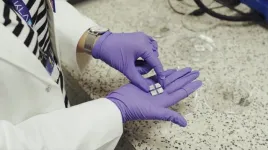(Press-News.org) Metabolic pathways consist of a series of biochemical reactions in cells that convert a starting component into other products. There is growing evidence that metabolic pathways coupled with external stress factors influence the health of cells and tissues. Many human diseases, including retinal or neurodegenerative diseases, are associated with imbalances in metabolic pathways. Elisabeth Knust leads a team of researchers from the Max Planck Institute of Molecular Cell Biology and Genetics (MPI-CBG) in Dresden, Germany, who describe an essential role for one such metabolic pathway in maintaining retinal health under conditions of stress. They studied the classic Drosophila genes cinnabar, cardinal, white, and scarlet, originally characterized decades ago and named due to their role in eye color pigmentation, in particular the formation of the brown pigment of the fly eye. These genes encode components of the kynurenine pathway, whose activity converts the amino acid tryptophan by various steps into other products. In this study, the authors have highlighted the function of this metabolic pathway in retinal health, independent of its role in pigment formation.
The Kynurenine pathway is an evolutionary conserved metabolic pathway that regulates a variety of biological processes. Its disruption can result in the buildup of either toxic or protective biomolecules or metabolites, which can worsen or improve, respectively, the health of the brain, including the retina. Knowledge on this important metabolic pathway was recently extended by the research team, led by Elisabeth Knust, Director Emerita at the MPI-CBG, in their publication in the journal Plos Genetics. Being aware of the remarkable conservation of this metabolic pathway and the genes that regulate it, they used flies as a model system to unravel the role of individual metabolites in retinal health. The researchers looked at four genes – cinnabar, cardinal, white, and scarlet – named after abnormal eye colors following their loss in flies. “Since the Kynurenine pathway is conserved from flies to humans, we asked whether these genes regulate retinal health independent of their role in pigment formation,” says Sarita Hebbar, one of the lead authors of the study.
To find this out, the scientists used a combination of genetics, dietary changes, and biochemical analysis of metabolites to study different mutations of the fruit fly, Drosophila melanogaster. Sofia Traikov, a co-author, developed a method for the biochemical analysis of the metabolites of the Kynurenine pathway. This allowed the researchers to link different metabolite levels to the health state of the retina. They found that one metabolite, 3-hydroxykynurenine (3OH-K), is damaging to the retina. More importantly, they could show that the degree of degeneration is influenced by the balance between toxic 3OH-K and protective metabolites, such as Kynurenic Acid (KYNA), and not just by their absolute amounts. Sarita continues: “We also fed two of these metabolites to normal (non-mutant) flies and found that 3OH-K enhanced stress-induced retinal damage, whereas KYNA protected the retina from stress-related damage.” This means that retinal health in certain conditions can be improved by altering the ratio of metabolites of the Kynurenine pathway.
Furthermore, by targeting these four genes and therefore four distinct steps within the pathway, the researchers were able to demonstrate that not only the accumulation of 3OH-K as such, but also its location in the cell and hence its availability in further reactions, is important for retinal health.
“This work shows that the Kynurenine pathway is important not only in pigment formation but that the level of individual metabolites fulfills important roles in maintaining retinal health,” says Elisabeth Knust, who supervised the study. She concludes, “In the future, the ratio of the various metabolites and the specific sites of their accumulation and activity should be taken into account in therapeutic strategies for diseases with impaired Kynurenine pathway function, observed in various neurodegenerative conditions.”
END
Eye color genes are critical for retinal health
Researchers from Dresden investigated how four Drosophila genes, known to control eye color, are essential for health of retinal tissue
2023-03-23
ELSE PRESS RELEASES FROM THIS DATE:
Can insights from the soapbark tree change the way we make vaccines?
2023-03-23
The medicinal secrets of the Chilean soapbark tree have been laid bare, unlocking a future of more potent, affordable, and sustainably sought vaccines.
The evergreen species, Quillaja saponaria has, for decades, been highly prized for producing molecules called QS saponins, which are used in the food and drinks industry as foaming agents.
More recently an important new function has emerged with saponins obtained from the tree’s bark used as potent adjuvants in the production of vaccines. Adjuvants play a critical role in some vaccines, working to boost the potency of a vaccine by enhancing the host immune response.
Molecules extracted from soapbark tree are ...
Autism rates continue to rise in California
2023-03-23
A new report from the Centers for Disease Control and Prevention (CDC) shows the rates and demographics of children with autism spectrum disorder (ASD) are changing in the United States.
In the latest analysis, 1 in 36 8-year-old children (2.8%) have been identified as having ASD. This figure is higher than the previous estimate published in December 2021, which found a prevalence of 1 in 44 (2.3%) children, and considerably higher than the CDC’s first autism prevalence report published in 2007 noting a prevalence of 1 in 150 (0.7%).
Prevalence estimates also differed across the 11 data collection sites, ranging from 1 in 43 children (2.3%) in Maryland, to 1 in 22 (4.5%) ...
Artificial intelligence predicts genetics of cancerous brain tumors in under 90 seconds
2023-03-23
Using artificial intelligence, researchers have discovered how to screen for genetic mutations in cancerous brain tumors in under 90 seconds — and possibly streamline the diagnosis and treatment of gliomas, a study suggests.
A team of neurosurgeons and engineers at Michigan Medicine, in collaboration with investigators from New York University, University of California, San Francisco and others, developed an AI-based diagnostic screening system called DeepGlioma that uses rapid imaging to analyze tumor specimens taken during an operation and detect genetic mutations more rapidly.
In a study of more than 150 patients ...
SLU research finds improved wastewater treatment could lead to significant reduction in greenhouse gas emissions
2023-03-23
ST. LOUIS – Research published in Environmental Research Letters has shown that methane emissions from urban areas are underestimated by a factor of three to four and that untreated wastewater may be a contributing factor.
The study, “Investigating high methane emissions from urban areas detected by TROPOMI and their association with untreated wastewater,” was led by Benjamin de Foy, Ph.D., professor of Earth and Atmospheric Sciences at Saint Louis University, and published online on ...
What really matters in multi-story building design?
2023-03-23
The impact of multi-storey building design considerations on embodied carbon emissions, cost, and operational energy has been revealed for the first time.
Using a computer model, researchers estimate that up to six gigatonnes of carbon could be saved by 2050 if new multi-storey buildings follow certain recommendations during the design process. All these recommendations, which could also save between 28 and 44% of annual heating and cooling costs, use technology that is currently available.
Construction and operation of buildings account for more than one-third ...
UTEP joins project to 3D print batteries from lunar and Martian soil
2023-03-23
EL PASO, Texas (March 23, 2023) – The University of Texas at El Paso has joined a project led by NASA to leverage 3D-printing processes with the aim of manufacturing rechargeable batteries using lunar and Martian regolith, which is the top layer of materials that covers the surface of the moon and Mars.
“UTEP is a national leader in additive manufacturing for space applications,” said Kenith Meissner, Ph.D., dean of the UTEP College of Engineering. “I congratulate the team of UTEP researchers involved in this important work. I am confident their work will add significant value ...
For stressed-out grad students, mindfulness makes big difference
2023-03-23
MADISON – While recent studies and polls indicate the nation is in the midst of a mental health crisis, the situation in academia is even more grim: Within the high-stress, high-pressure, often socially isolated world of advanced education, graduate students experience depression and anxiety at six times the rate of the general population.
Normalizing mindfulness practices within the graduate student experience may be an answer, according to a three-year study conducted by University of Wisconsin–Madison ...
Alzheimer's early detection through biomarkers -
2023-03-23
Scientists from Swansea University ‘s Institute for Innovative Materials, Processing and Numerical Technologies (IMPACT) and Japan have been awarded £1.3 million to develop a new “point of care testing” kit that can detect biomarkers for Alzheimer's Disease.
The project follows Dr Sanjiv Sharma’s ground-breaking work in this area and the development of the world’s first COVID-19 ‘smart patch’.
Compared to hypodermic single needles, a ‘smart patch’ consists of a collection of tiny needles - microneedles - created to break the skin barrier in a minimally invasive ...
Rates of autism climb to new highs in the U.S., with California setting record numbers
2023-03-23
New federal studies coauthored by autism experts at Rutgers found that more children have been diagnosed with autism than at any time since monitoring began more than two decades ago.
According to the U.S. Centers for Disease Control and Prevention (CDC), about 4 percent of 8-year-old boys and 1 percent of 8-year-old girls, have autism in the U.S. These estimates are the highest since the CDC’s Autism and Developmental Disabilities Monitoring (ADDM) Network was created in 2000.
Biennial studies from the ADDM Network, which analyzed ...
Study uncovers aspect of how muscular dystrophies progress
2023-03-23
A research study has shed new light on how congenital muscular dystrophies such as Walker-Warburg syndrome progress, bringing hope for better understanding, early diagnosis and treatments of these fatal disorders.
Published in March in the Journal of Biological Chemistry, the research was led by scientists in the lab of Vlad Panin, Ph.D., professor in the Department of Biochemistry and Biophysics in the Texas A&M College of Agriculture and Life Sciences. The study is titled “Protein tyrosine phosphatase 69D is a substrate of protein O-mannosyltransferases 1-2 that is required for the wiring of sensory axons in Drosophila.” ...
LAST 30 PRESS RELEASES:
Numbers in our sights affect how we perceive space
SIMJ announces global collaborative book project in commemoration of its 75th anniversary
Air pollution exposure and birth weight
Obstructive sleep apnea risk and mental health conditions among older adults
How talking slows eye movements behind the wheel
The Ceramic Society of Japan’s Oxoate Ceramics Research Association launches new international book project
Heart-brain connection: international study reveals the role of the vagus nerve in keeping the heart young
Researchers identify Rb1 as a predictive biomarker for a new therapeutic strategy in some breast cancers
Survey reveals ethical gaps slowing AI adoption in pediatric surgery
Stimulant ADHD medications work differently than thought
AI overestimates how smart people are, according to HSE economists
HSE researchers create genome-wide map of quadruplexes
Scientists boost cell "powerhouses" to burn more calories
Automatic label checking: The missing step in making reliable medical AI
Low daily alcohol intake linked to 50% heightened mouth cancer risk in India
American Meteorological Society announces Rick Spinrad as 2026 President-Elect
Biomass-based carbon capture spotlighted in newly released global climate webinar recording
Illuminating invisible nano pollutants: advanced bioimaging tracks the full journey of emerging nanoscale contaminants in living systems
How does age affect recovery from spinal cord injury?
Novel AI tool offers prognosis for patients with head and neck cancer
Fathers’ microplastic exposure tied to their children’s metabolic problems
Research validates laboratory model for studying high-grade serous ovarian cancer
SIR 2026 delivers transformative breakthroughs in minimally invasive medicine to improve patient care
Stem Cell Reports most downloaded papers of 2025 highlight the breadth and impact of stem cell research
Oxford-led study estimates NHS spends around 3% of its primary and secondary care budget on the health impacts of heat and cold in England
A researcher’s long quest leads to a smart composite breakthrough
Urban wild bees act as “microbial sensors” of city health.
New study finds where you live affects recovery after a hip fracture
Forecasting the impact of fully automated vehicle adoption on US road traffic injuries
Alcohol-related hospitalizations from 2016 to 2022
[Press-News.org] Eye color genes are critical for retinal healthResearchers from Dresden investigated how four Drosophila genes, known to control eye color, are essential for health of retinal tissue





